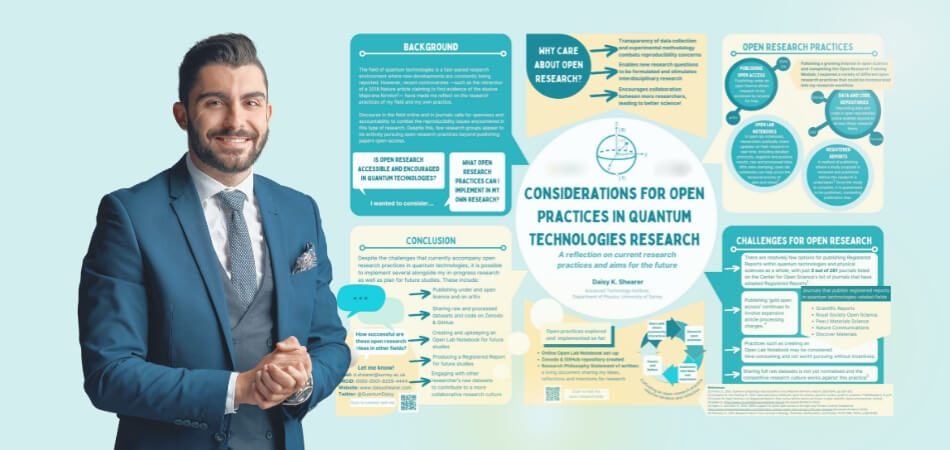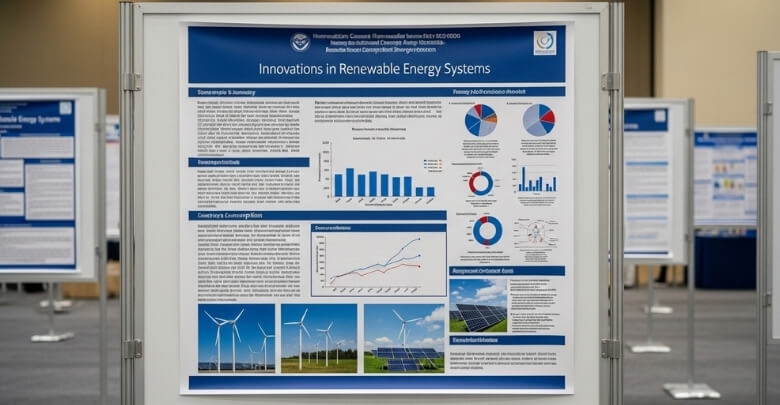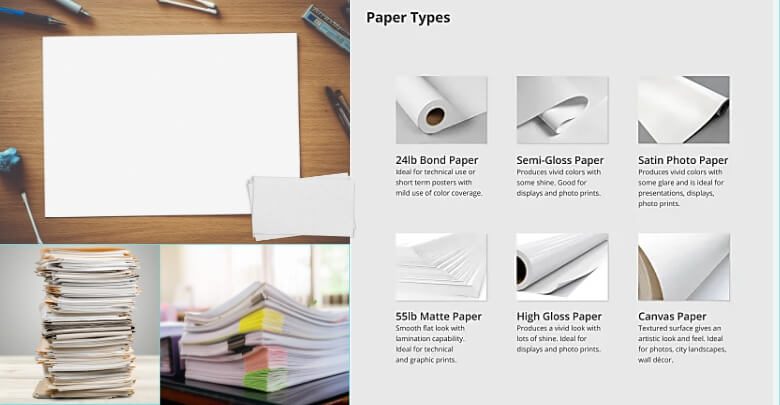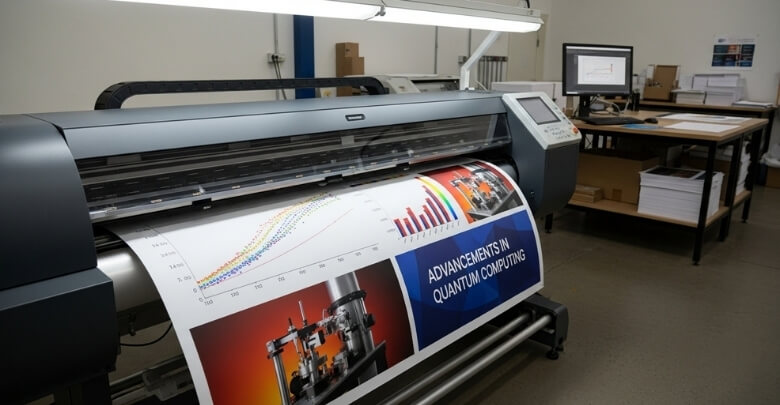Conferences bring people together to share new ideas, research, and creative work, often through colorful posters displayed in large halls. While preparing for one, many wonder, What paper do you use to print a conference poster?
Use matte, satin, or fabric paper to print a conference poster. Matte reduces glare and improves readability, satin balances color and clarity, and fabric is travel-friendly and reusable. Choose based on lighting, content type, and travel needs.
If you are curious about which option works best for your needs, this article explains everything in detail. You will learn about paper finishes, travel-friendly choices, cost differences, and tips to make your poster professional and easy to read.
What Paper Do You Use to Print a Conference Poster?
Choosing the right paper is an important step in preparing a poster presentation, as it shapes how the work looks and reads. Some paper finishes reduce glare while others highlight colors more. If you want your poster to stand out and still be practical, the right choice of paper is important. Let’s look at the options that work best for a conference poster.
Matte Paper
Matte finish works well when a poster includes a lot of text or detailed graphics. Its non-reflective surface keeps the design clear and easy to read, especially under strong lights in a conference hall. Many presenters prefer matte because it avoids the shiny distractions of glossy paper, allowing the audience to focus fully on the content without glare.
Satin Finish
Satin, or semi-gloss, offers a middle ground between matte and glossy. This finish gives a soft shine that enhances colors but avoids the harsh glare of glossy surfaces. It’s a solid choice for posters that mix visuals and text, balancing readability with brightness. Many presenters use satin to make colors pop a little without overshadowing the written content.
Glossy Paper
Glossy paper is known for making colors look extra bright and eye-catching. If your poster includes bold photos, artwork, or graphics, this finish can make them stand out. However, glossy paper can cause glare under direct lighting, which sometimes makes text harder to read. It works best in places where the lighting can be controlled or when visuals are the main focus of the poster.
Fabric Option
Fabric posters, often made from polyester, are very popular with people traveling to events. They can be folded and packed easily into a bag or suitcase, which makes them perfect for long flights. If you are going to an international conference in Canada, for example, fabric posters would be easy to carry and stay wrinkle-free. They are also durable and can be reused for multiple events, which adds to their value.
Durability
One important factor to think about is how durable the material needs to be. If your poster will only be used once, paper may be enough. But if you plan to use the poster at more than one event, fabric might be better. Fabric does not tear easily and remains in good shape even after being folded, unlike paper, which can crease or get damaged during travel.
Printing Quality
The finish of your paper affects how sharp the printing looks. Matte makes text very readable but may soften colors slightly. Satin gives a good mix of sharp text and bright visuals. Glossy makes images and graphics look bold but may reduce the readability of detailed text. Knowing your main focus helps you pick the finish that works best for your content.
Travel Needs
If you need to travel with your poster, portability is something to think about. Carrying a rolled paper poster in a tube can be heavy and inconvenient. On the other hand, fabric posters fold up small and fit in regular luggage. This makes them more practical for air travel, especially when you are attending conferences far from home.
Conference Rules
Always check if the conference has specific poster size or material rules. Some events may only allow certain dimensions or may suggest a preferred finish. Following these rules makes sure your poster is accepted and looks professional when displayed. It also saves you from last-minute printing problems.
Image Resolution
The quality of your images also matters. No matter which paper you choose, make sure to use high-resolution images of at least 300 DPI. This prevents blurry or pixelated visuals and ensures your poster looks professional. Clear images and readable text will leave a stronger impression on the audience.
Poster Size
Designing your poster at its actual final size is important. This avoids scaling problems that can stretch or blur your design. Before printing, confirm the size that the conference accepts and prepare your file to match those dimensions. A properly sized poster looks neat and professional once displayed.
The best paper type depends on your content, travel plans, and the setting of the event. Choosing wisely ensures your poster looks clear, professional, and leaves a strong impression. Picking the right poster paper type can also save you from common issues like glare, smudges, or bulky materials during travel.
Should You Use Glossy or Matte Paper for Conference Posters?
When making a conference poster, one of the main choices is whether to print on glossy or matte paper. Both finishes have their own strengths and weaknesses, and the right option depends on how you want your poster to look and how it will be viewed. If you are comparing matte vs glossy poster conference options, the table below shows their features side by side so you can pick the best finish for your needs.
| Feature | Glossy Paper | Matte Paper |
| Color Brightness | Makes colors pop. Reds, blues, greens look more vivid. | Colors are softer. They are less intense but look smoother. |
| Contrast | High contrast between colors and text. Good for graphics and photos. | Moderate contrast. Works well, especially for large solid color areas. |
| Readability under Lights | Might get glare (shine) under bright lights. That glare can make parts hard to read. | Less glare. Easier to read under different kinds of lighting. |
| Readability from Distance | Very good, provided there’s no glare. Texts and charts stand out. | Also good. Sometimes easier to read because glare won’t mask parts. |
| Fingerprints and Smudges | More visible. Oils or dust show up easily because of the shine. | Less visible. Matte hides smudges better. |
| Durability | Glossy can be scratched more easily. Scratches are more noticeable. | More forgiving if scratched or handled roughly. |
| Professional / Formal Look | Looks sleek, modern. Great for photos, colorful images. | Looks more subtle, elegant. Good for academic, text-heavy posters. |
| Cost | Often more expensive. Printing needs more care. | Usually cheaper. Easier to print well. |
| Best Use | Posters with a lot of photos, graphics, rich color, and when the lighting is controlled. | Posters with many texts and diagrams, when the lighting is bright or unpredictable. |
Glossy paper makes colors look brighter but can cause glare under lights, while matte paper gives a softer look and is easier to read in most lighting. If your poster is heavy on photos, glossy might work better, but for text-heavy or academic posters, matte is often the safer choice.
Can You Print a Conference Poster on Fabric Instead of Paper?
Most people picture big paper sheets for posters, yet fabric posters are becoming a practical and professional alternative. They look professional and come with some very practical benefits. Let’s take a closer look at why fabric posters can be a great choice.
Easy Transport
Fabric posters are light and simple to carry. Instead of worrying about a big paper roll, you can fold the fabric and put it in your bag. This makes travel stress-free because the poster does not take up much space and is easy to manage.
Foldable Design
One of the best things about fabric posters is that they can be folded. Unlike paper, you do not need a hard tube for protection. You can fold it like clothes, and it will still look fine when displayed. This gives more freedom while packing.
Long Lasting
One advantage of fabric posters is their strength; they don’t tear easily. Even after being folded or used multiple times, they stay in good shape. This makes them a smart option for anyone planning to reuse a poster at more than one event or conference.
Wrinkle Resistant
Fabric posters handle wrinkles much better than paper. If it gets a little wrinkled, a quick touch with a warm iron or steamer will make it smooth again. This means you always present a neat and professional-looking poster without much effort.
Professional Look
Fabric posters give a high-quality finish that looks stylish. The colors are bright, and the surface has a soft texture that stands out. This makes your work look even more impressive and catches the attention of people walking by.
Printing a poster on fabric instead of paper is not only about looks, but also about comfort and durability. If you want something easy to carry, fold, and reuse, fabric posters are an excellent choice.
What Printing Options Are Best for Traveling with a Conference Poster?
One of the biggest concerns with conference posters is figuring out how to carry them safely. Posters are large and not always travel-friendly, so choosing the right printing option makes a big difference. Here are some practical printing options you can consider:
- Foldable Fabric Posters: These are made from special fabric that can be folded like clothes and packed in a suitcase without causing permanent creases or tears.
- Lightweight Paper Posters: Using thin but strong paper makes the poster easy to roll and carry in a poster tube, reducing both weight and space issues.
- Print-on-Demand Services: Many conference cities have printing shops that allow you to upload your file online and pick up the poster when you arrive.
- Durable Matte Finish: Choosing a matte finish on either fabric or paper avoids glare under strong lights, and it makes the poster easier to read from different angles.
- Compact Poster Tubes: If you go for paper printing, carrying it in a small, lightweight tube protects it from bending, rain, or accidental damage during the trip.
- Digital Backup Ready: Always carry a digital copy of your poster file on a USB or cloud storage, so you can quickly reprint if needed at the venue.
- Check Airline Rules: Some airlines count poster tubes as extra carry-on items, so knowing the rules beforehand can save you from last-minute trouble at the airport.
Choosing the right option helps reduce travel stress and keeps your work looking professional. Whether you fold it, roll it, or print it nearby, the goal is to keep it safe and easy to present.
How Does Paper Choice Influence the Overall Impact of a Poster?
People preparing posters for events often focus on design and content, but the paper finish plays an equally important role. A poster that looks neat and clear can easily catch attention. If you want to learn how paper choice shapes the overall impact, then keep reading for the details.
Visual Appeal
Paper type affects how colors appear on your poster. Glossy paper makes images bright and bold, while matte paper gives a softer but more readable look. Satin is in between, showing colors nicely but without strong glare. Picking the right finish helps your poster stand out without distracting the audience.
Readability
The way your text looks depends on the paper finish. Matte is the easiest to read under bright lights, as it reduces reflections. Satin keeps words clear but adds a light shine. Glossy, though colorful, can make text hard to read under strong lighting. Clarity should always come first.
Professional Look
Posters that use the right paper finish create a professional impression. Matte shows seriousness and focus, satin adds a polished touch, and glossy highlights creativity. The paper’s finish shapes readability and visual appeal, and this often comes up alongside tips for presenting a poster at a conference that stress clarity and audience engagement.
Practical Use
Some finishes are better when you need to travel. Fabric posters fold easily, do not wrinkle much, and are lighter to carry. Paper posters, especially glossy ones, need careful rolling and storage. Considering how you will transport the poster makes a difference in ease and convenience.
Audience Impact
The final goal of any poster is to engage the audience. A good paper choice makes it easier for viewers to notice, read, and remember your work. A balanced finish ensures both the design and content are seen clearly, leaving a stronger impression overall.
Paper type is not just about looks but also about function. Choosing carefully ensures your poster communicates your message clearly and leaves a lasting impact.
How Much Does It Cost to Print a Conference Poster on Different Paper Types?
Printing a conference poster isn’t just about the design—it also comes with costs that depend on paper type, size, and finish. From basic standard paper to durable fabric posters, each option has its own price range and benefits. Knowing the differences helps you plan your budget wisely and pick the best fit for your event needs.
Standard Paper
Standard paper is the cheapest option and works fine for short-term use. A large 36″×48″ poster usually costs around 80 to 110 dollars, while a smaller 24″×36″ one costs 25 to 45 dollars. This option is light, basic, and does not include lamination or heavy finishes.
Premium Glossy
Glossy paper makes colors look brighter and sharper, but it costs more than standard paper. A 36″×48″ glossy poster is often priced between 95 and 130 dollars, while smaller ones go for 35 to 60 dollars. Glossy looks nice, but may show glare under lights.
Matte Finish
A matte finish is popular because it cuts down glare and looks clean. Posters with matte lamination or heavy photo-quality paper range from 110 to 150 dollars for a 36″×48″ size. Smaller ones usually cost 40 to 70 dollars. Matte options also make the poster more durable.
Fabric Posters
Fabric posters are easy to fold, light to carry, and strong for travel. Prices are higher though, usually 125 to 180 dollars for a 36″×48″ poster and 50 to 90 dollars for a smaller one. Many people like this option for international conferences.
Extra Costs
Besides paper choice, prices can rise due to shipping, faster turnaround times, or custom finishes. Rush orders usually add a big extra fee. Ordering more than one poster at once can save money per piece. Lamination or special coatings also increase the total cost.
Printing a poster is not one-size-fits-all. The cost changes with size, paper quality, finish, and delivery speed. If you know your needs, you can balance between price and quality to get the best value.
How Do Design Tools Influence the Final Print of a Conference Poster?
Design tools play a big role in how a poster looks when printed. The choice of software, layout style, and formatting settings can all make a difference in the final result. Let’s explore how design tools can shape the outcome.
Layout Accuracy
The design tool you use decides how well the layout appears on the printed poster. Some tools keep the sizes, margins, and alignment accurate. If the layout is off, the poster may look uneven or unprofessional after printing, which reduces its overall impact.
Color Quality
Colors on a screen may look different from colors on a printed poster. Good design tools have options to set the right color codes for printing. This makes sure the final poster looks close to what you see on the screen with bright and clear shades.
Font Choices
Fonts are not just about style; they also affect readability. Some tools support a wide range of fonts, while others may limit your options. Picking the right font size and type makes the content easy to read, even from a distance.
Image Clarity
High-quality images are important for posters. A good design tool helps maintain the sharpness of pictures and graphics during printing. If the tool reduces image quality, the poster might look blurry or stretched, which can distract from the main message.
Print Compatibility
Many presenters rely on software like making conference posters in PowerPoint before choosing the right paper for printing. Tools that allow exporting in high-resolution formats such as PDF or TIFF make printing smoother and ensure the final poster comes out looking neat and polished.
The design tool you select is just as important as the content you put on the poster. It influences layout, clarity, and print quality. Choosing the right tool helps you create a poster that looks professional and stands out.
FAQs About What Paper Do You Use to Print a Conference Poster?
The thickness of the paper matters because it affects how strong the poster feels. A thicker paper, like 180–200 gsm, is more durable and less likely to curl at the edges. Thinner paper may wrinkle or tear easily, especially if you travel with it. Most printing shops recommend medium-thick paper for a good balance of durability and cost, which is often the most practical choice for a scientific poster paper type.
Can Recycled Paper Be Used for Conference Posters?
Yes, recycled paper can be used, but the quality depends on the type you choose. Some recycled papers may not show bright colors as well as glossy or matte options. If your poster has more text, recycled paper works fine. If you want sharp images, you may need to pick a higher-grade recycled paper.
Is Photo Paper a Good Choice for Conference Posters?
Photo paper can make your images look sharp and colorful, but it is not always practical. It is heavier, more expensive, and often harder to transport in large sizes. While it works well for smaller posters or displays, it may not be the best choice for big conference posters. Always check if your printer supports large photo paper sizes before choosing it.
What Paper Size Do Most Printers Support for Conference Posters?
Most printers support standard poster sizes like 24″×36″ and 36″×48″. These are the common sizes accepted by many conferences. Larger sizes are possible, but they may cost more and take longer to print. Before printing, it’s important to confirm the exact size allowed by your event.
Are Rollable Papers Better Than Flat Papers for Posters?
Rollable papers are easier to carry because you can put them in a poster tube. They are strong enough to handle rolling without damage if the paper is thick enough. Flat papers need large boards or envelopes, which are harder to travel with. For most people, rollable options are more practical.
Do Printers Offer Waterproof Paper for Conference Posters?
Yes, some printers offer waterproof or water-resistant paper options. This type of paper is coated to handle spills or light rain. It is more expensive, but it can save your poster if you need to carry it outdoors. Waterproof paper is not always necessary, but it can be useful for safety.
Can You Laminate a Conference Poster After Printing?
Yes, lamination is possible and makes the poster last longer. A laminated poster is stronger, resists wrinkles, and is easier to clean. However, lamination adds weight and makes rolling the poster more difficult. It’s a good option if you plan to use the same poster at multiple events.
What Is the Difference Between Inkjet and Laser Printing for Posters?
Inkjet printing usually gives brighter colors and works better for photos and graphics. Laser printing is sharper for text, but may not handle big, colorful images as well. For conference posters that have both text and visuals, inkjet is often the better choice. Always ask the printer what type they use.
Can Posters Be Printed on Banner Material Instead of Paper?
Yes, some shops can print posters on vinyl banner material. This option is very durable and resists tearing or wrinkling. It is heavier than paper, but it can be used multiple times without damage. Banner material is more costly but useful if you need extra strength.
Does Paper Type Affect How Much Ink Is Used?
Yes, the type of paper changes how much ink is needed. Glossy and photo papers usually use more ink to make colors brighter. Matte and standard papers use less but may not look as bold. Choosing the right paper helps balance quality and printing cost.
Conclusion
The type of material and finish you select for your conference poster directly affects how it is received by the audience. From color clarity to readability under strong lights, each choice has its own benefits and drawbacks that shape the overall presentation. Picking the best paper for posters depends on finding the right balance between durability, print quality, and easy handling.
When you ask what paper do you use to print a conference poster? the simple answer is that it depends on your content and setting. Matte works best for text-heavy posters, glossy for bright visuals, satin for balance, and fabric when travel convenience matters most.
To make the most of your poster, always prepare high-resolution files, check conference size rules, and think about travel needs. A neat, readable, and durable poster will always stand out. Best of luck with your presentation and printing!









